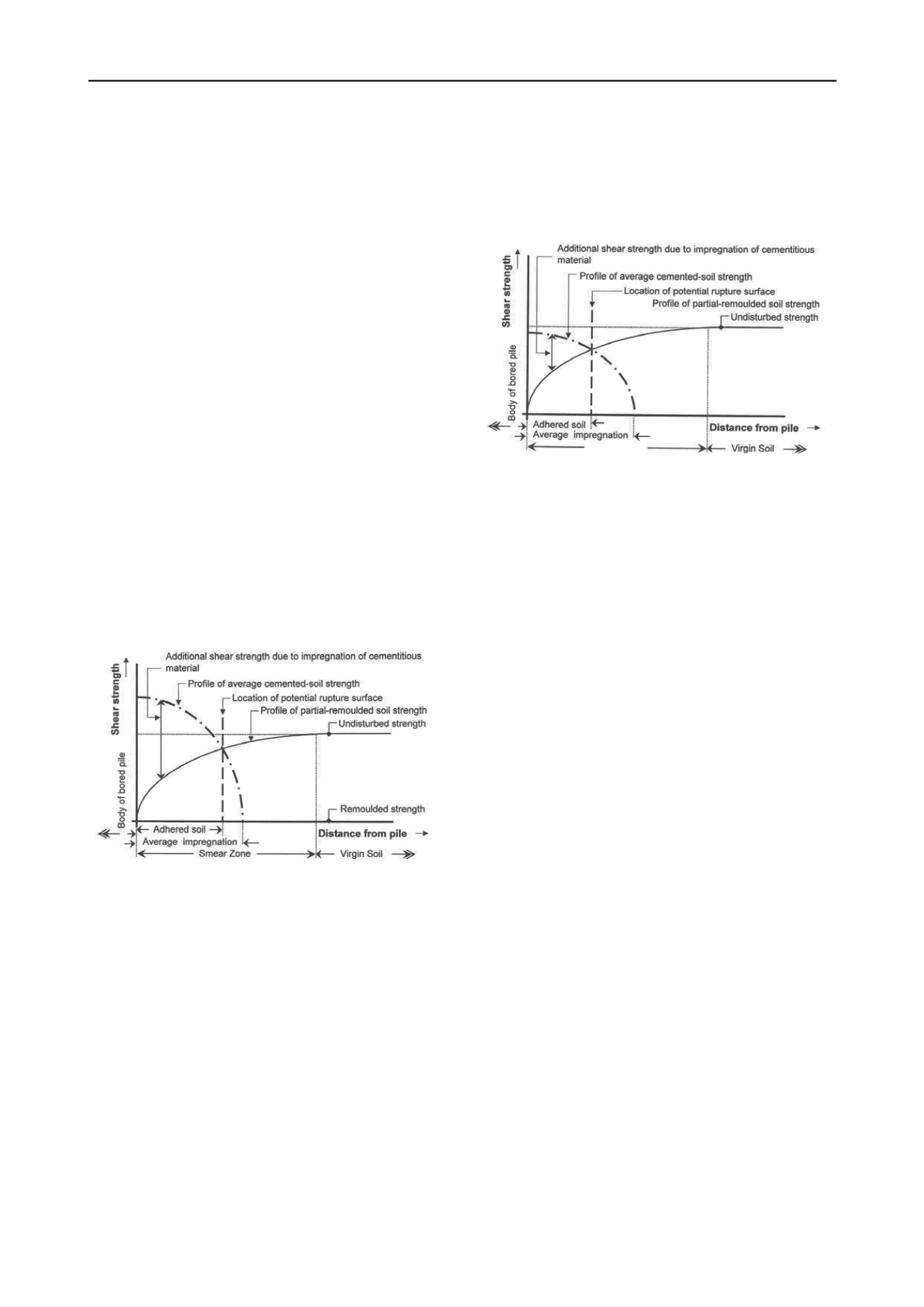
948
Proceedings of the 18
th
International Conference on Soil Mechanics and Geotechnical Engineering, Paris 2013
of the objectives of the research (Sarma, 2000) to evaluate the
depth of smear zone, intensity of smear, and effect of
impregnation under laboratory test conditions.
4 IMPREGNATION AND ITS EFFECT ON INTERFACE
STRENGTH
Fresh concrete forces the softened/loosened soil partially
outward from the borehole owing to its larger unit weight and
pressure head developed during placement and concreting
operations. This creates further disturbances to the soils.
Specific gravity of the fresh concrete being higher than that of
the in-situ soil and due to positive pressure developed
particularly in tremie action cementitious slurry, which is one of
the constituents of the fresh concrete, always exists at higher
than the ground water pressure unless an artesian flow of higher
order reverse the situation. Therefore, in general, a tendency for
impregnation of cementitious slurry from the body of the
freshly cast deep foundation towards the less stressed zone
surrounding the borehole always exists until a state of
equilibrium of slurry pressure in the pores of surrounding soil is
attained. Such impregnation of cementitious slurry alters the
physico-chemical characteristics of soil within the impregnated
zone and upon setting strengthens smear/distortion zone within
the impregnation depth.
5 MOBILISATION OF SHAFT RESISTANCE
The philosophy of soil-structure interface strength based on the
effect of distortion or smear zone and impregnation of
cementitious slurry together, can be visualised in the following
way:
Figure 1 (a). Idealised profiles at soil-structure interface, cemented
rength
egnated strength of soil is lower
an its undisturbed strength
, cemented
rength less than undistur
tial remoulded strength
dep
y be idealised within the
ext
te due to the
com
to stabilise the borehole,
ffective
dia
st
more than undisturbed strength (After Sarma, 1992)
It was asserted that the impregnated cement slurry improves
the shear strength of part of the distortion zone surrounding cast
in-situ deep foundation (Sarma, 1992). Also during curing,
concrete absorbs moisture from the surrounding soil and thus
soil gets consolidated to give better strength. This gain in
strength diminishes with increasing distance from the
foundation. On the other hand, intensity of remoulding /
loosening effect that causes shear strength to decrease in the
surrounding soil reduces away from the foundation. Hence the
rupture surface for mobilisation of shaft resistance does not
exactly lie at the interface of the concrete of the foundation and
soil. It is possible that the weakest surface may exists away
from the body of foundation as a result of the two opposing
effects mentioned above. Therefore soil up to the weakest
surface may adhere to the foundation surface behaving as its
integral part. In such a case slip or local yield that occur when
the shear stress reaches the adhesive (or yield) strength may not
occur at soil-structure interface rather between adhered and
surrounding soil. Two different possibilities have been
presented. Fig. 1(a) portrays potential rupture surface in case
cement impregnated strength of soil is higher than its
undisturbed strength and Fig. 1(b) portrays potential rupture
surface in case cement impr
th
Figure 1(b). Idealised profiles at soil-structure interface
st
bed strength (After Sarma, 1992)
In both the figures soil-structure interface shear strength is
presented in the ordinates. Therefore, any point towards left of
the ordinates will represent the body of foundation. The profile
of the shear strength of soil due to the effect of smear is shown
with minimum remoulding strength at the soil-structure
interface where extent of smear is maximum and strength
increases away from the interface. It will be undisturbed shear
strength at the end of smear zone due to the diminishing affect
of smear. Any point at the profile of shear strength of soil
within smear zone will represent par
ending upon the severity of smear.
On the other hand cemented soil strength, i.e., soil shear
strength due to the effect of impregnation of cementitious
material, will be maximum at the soil-structure interface. The
cemented soil strength has a diminishing trend away from the
body of the foundation up to the remoulded shear strength of
soil at the end of impregnation. This ma
ent of average impregnation depth.
The combined effect of cemented soil strength, which has
diminishing tendency, and remoulded shear strength which has
increasing tendency from the body, may act as the mobilised
shear strength of soil surrounding the shaft. It is clear from the
figure that potential rupture surface exists at the point where
mobilised shear strength attains a minimum value. The soil up
to the potential rupture surface will act as a part of the shaft that
affects increased diameter. With the fact that the potential
rupture surface exists away from the shaft, the average shear
strength of the soil within the impregnated zone may be either
lower or higher than that of the undisturbed sta
bined effect of smear and cemented strength.
While formulating the philosophy of this radical concept of
soil-structure interface strength it is considered that the depth of
impregnation is less than the depth of smear. The depth of
impregnation being more than the depth of smear is possible
only in case of granular soil. This is ruled-out as bentonite
slurry, which is generally used
impregnates prior to cement slurry.
6 FIELD EVIDENCES OF IMPREGNATION
Piles pulled out of soil frequently appear with a skin of soil
sometime several mm thick adhering tightly to the surface of the
pile thus becoming a part of the pile itself (Bowles, 1988). Field
evidence of such a phenomenon was noticed and reconfirmed
by this author too during excavation for construction of deep
pile caps. Due to soil adhering to the pile surface the e
meter, at which shaft resistance mobilises, increases.
Field investigation reveals that soil becoming a part of pile,
with a thick skin of adhered soil, is prominent in case of cast in-


